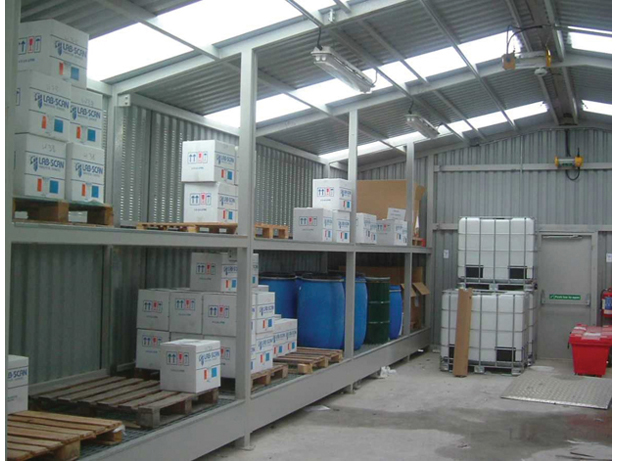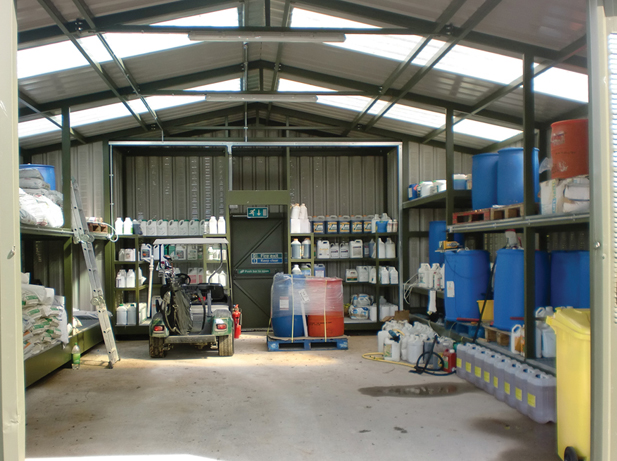While the utmost care should always be taken when working with chemicals, placing emphasis on site safety when storing large volumes in a chemical storage warehouse is essential. The following are six safety considerations we believe every large chemical storage facility should implement.
- Bunded Floors
Spill control is always a concern when storing chemicals. Bunds and Spill Decks can be put in place to capture spilled chemicals and dramatically increase site safety. These plastic spill decks are designed to support chemical containers and machinery, while also catching chemical spills. This prevents the leak from spreading throughout the warehouse, and makes clean up far easier. They can be attached to create an entire floor, though if only one or two sections of the warehouse are intended to be used, it is still advised to place them beneath any drums stored in the warehouse.
- Designating a Chemical Transfers Area
A large majority of chemical storage warehouse incidents occur when transferring chemicals. To start, all new chemicals should have their containers and safety data sheets examined when they arrive in your warehouse. Set aside a set-down area for this purpose, as if they go straight onto the shelves, they could begin leaking unnoticed. Designate yet another secure area for transferring chemicals from one container to another. Leaks and spills easily occur at this stage, and so bunded flooring is a must for this section. You should also ensure all staff are aware they must transfer the relevant hazard signage from one container to the next.
- Chemical Storage Classifications
Organising your chemical storage can be quite the task, with many different considerations to take into account. An easy way to increase site safety is to store them by chemical classification. This ensures that non compatible chemicals are segregated from each other and each section can have the correct safety measures taken, such as regulated temperatures for flammable chemicals, and plastic shelving for corrosive chemicals. Moreover, designated areas work to prevent cross contamination and reactions from chemical leaks mixing together. Each section should have a safety data sheet at hand, to help employees identify the risks of each chemical.
- Chemical Safety Protection
All chemical storage warehouses are required by law to have emergency response and first aid equipment available. Designated employees must be trained to use this equipment, though the number of first aiders required may differ based on your operation size. This equipment should include a spill kit, personal protective equipment for employees working on site, fire dampening measures and emergency showers and eyewashes. These should be tested regularly to make sure they’re working as necessary.
Your business should also have an emergency evacuation plan in place that is explained to all staff. The emergency exits must be kept clear at all times and all on site personnel should be aware of their location, as well as the actions they need to undertake in the evacuation process.
- Limit the Operation of Machinery
Most chemical storage warehouses require forklifts or other machinery to be operated within. However, such machinery easily cause incidents if they bump, jostle or drop sensitive chemicals. An easy way to increase warehouse security is to ensure only those trained to operate heavy equipment or machinery are authorised to drive them. Explain this to all staff, and consider keeping the keys in a locked box, that only the certified drivers have access too.
Other machinery protocol that should be put into place includes designated forklift routes throughout the warehouse, routes for trucks to unload products and speed limits while within the storage unit, or carrying chemicals.
- Keep Chemical Areas Secure
As chemicals are dangerous to untrained workers therefore all possible methods should be taken for securing the site. All exits to a chemical storage warehouse should be locked when authorised personnel leave (though the emergency exit should be locked from the inside and easily opened by staff), and the alarm coded. If possible, place cameras facing each exit to deter vandals or thieves, and allow you to monitor your business remotely.
We hope this helps you increase the safety of your chemical storage warehouse. For more information on this topic and more, browse our previous posts or contact us today.

